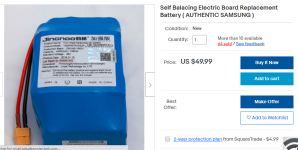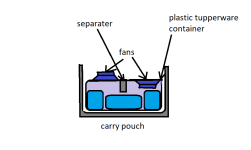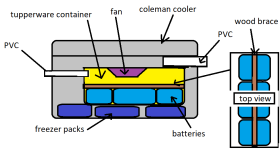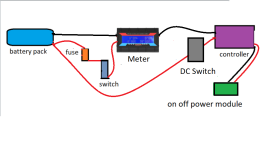You are using an out of date browser. It may not display this or other websites correctly.
You should upgrade or use an alternative browser.
You should upgrade or use an alternative browser.
new eZip motor
- Thread starter latecurtis
- Start date
- Status
- Not open for further replies.
latecurtis
100 MW
medical cannabis. They were doing curbside pick up for awhile and is about 5 miles one way so a nice bike ride.
I did not get full disability without numerous health issues. Degenerative disk disease , total knee replacement , osteoarthritis , carp tunnel , rotator cuff disease.
I was supposed to have disk replacement surgery and total knee replacement. My right toe is double the size of my left and tested negative for gout but have inflammatory joint disease.
I worked jackhammer and heavy demolition 15 years as well as power lifting 10 years.
My body is shot and the doctor recommended Opioids. Oxycotten.
I grew up with many people I lost to pills. I am against pills for pain. Cannibis is 100% natural and does help me deal with Chronic pain. That and a few beers late at night help me sleep as also have insomnia.
Thanks.
LC. out.
I did not get full disability without numerous health issues. Degenerative disk disease , total knee replacement , osteoarthritis , carp tunnel , rotator cuff disease.
I was supposed to have disk replacement surgery and total knee replacement. My right toe is double the size of my left and tested negative for gout but have inflammatory joint disease.
I worked jackhammer and heavy demolition 15 years as well as power lifting 10 years.
My body is shot and the doctor recommended Opioids. Oxycotten.
I grew up with many people I lost to pills. I am against pills for pain. Cannibis is 100% natural and does help me deal with Chronic pain. That and a few beers late at night help me sleep as also have insomnia.
Thanks.
LC. out.
latecurtis
100 MW
As he Hub Motor Turns and the LiPo Fire Burns. 10P - 36V old 4P - 36V new. 8P - next month.
I did not drink last night and was up early making the cable to run the new packs. I also had to hook up the thumb throttle so had to cut and tape wires because the plug on the new throttle was different than the old one that plugs in the controller. They were fully charged and went exactly 12.1 miles. I used google maps to find the distance. Voltage was 35.8V upon return.
I checked the old packs and the 4P SONA and 6P Samsung packs were less than a volt difference so I used the extra bullet cables to make parallel cables the same way I made the other cable and the old packs are in parallel and on the charger also.
The new pack was hot when I got back. I will need to open up the bag so it gets air. I was able to fit all the old packs in the bag the SONA packs were in so can put the new pack in the pouch the 6P Samsung's were in.
I am not sure if the new pack is really 14 AH or 13.5 AH but they went over 12 miles so I guess I might as well order a second one for 8P.. This will give me a total range of about 36 miles. Right now I have about 24 miles give or take a mile or 2.
The performance up hills was not much better than the old packs. I will see if there is any difference running the old packs in parallel at 10P. My guess is the controller is limiting the power output up hills and would make sense as it is a geared 500W motor. My experience tells me that 750 watts is the minimum for any decent performance up hills and 1,000W or more would be recommended.
I will be getting my gears fixed and brakes adjusted for more aggressive pedaling up hills. I noticed that the charger also gets hot on the new packs so have it in front of a 20" fan. I am still hoping to get a vehicle maybe this month or next month. I miss all my other e bikes and projects in my storage in NY.
Thanks.
LC. out.

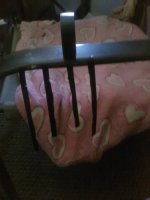
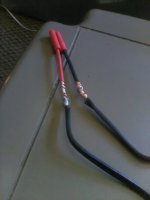
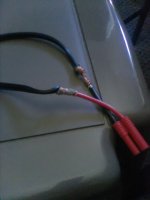
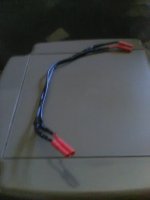

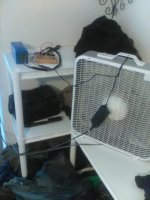
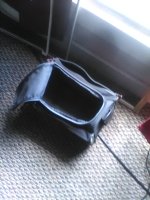
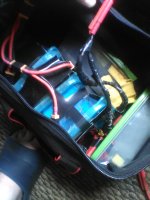
I did not drink last night and was up early making the cable to run the new packs. I also had to hook up the thumb throttle so had to cut and tape wires because the plug on the new throttle was different than the old one that plugs in the controller. They were fully charged and went exactly 12.1 miles. I used google maps to find the distance. Voltage was 35.8V upon return.
I checked the old packs and the 4P SONA and 6P Samsung packs were less than a volt difference so I used the extra bullet cables to make parallel cables the same way I made the other cable and the old packs are in parallel and on the charger also.
The new pack was hot when I got back. I will need to open up the bag so it gets air. I was able to fit all the old packs in the bag the SONA packs were in so can put the new pack in the pouch the 6P Samsung's were in.
I am not sure if the new pack is really 14 AH or 13.5 AH but they went over 12 miles so I guess I might as well order a second one for 8P.. This will give me a total range of about 36 miles. Right now I have about 24 miles give or take a mile or 2.
The performance up hills was not much better than the old packs. I will see if there is any difference running the old packs in parallel at 10P. My guess is the controller is limiting the power output up hills and would make sense as it is a geared 500W motor. My experience tells me that 750 watts is the minimum for any decent performance up hills and 1,000W or more would be recommended.
I will be getting my gears fixed and brakes adjusted for more aggressive pedaling up hills. I noticed that the charger also gets hot on the new packs so have it in front of a 20" fan. I am still hoping to get a vehicle maybe this month or next month. I miss all my other e bikes and projects in my storage in NY.
Thanks.
LC. out.









Sunder
10 MW
I'm surprised you're happy with 12 miles from a supposed 14ah pack, and not concerned that they are overheating on just 500w.
My commute is 12 miles (well, just under, 18km). But I am using 4ah albeit pedalling. That said, I am only putting out 180-200w according to the torque sensor. It's putting out 3-4x that.
Have you done an internal resistance test on that pack? If they were genuine samsungs, they should be good for well over 1000w.
My commute is 12 miles (well, just under, 18km). But I am using 4ah albeit pedalling. That said, I am only putting out 180-200w according to the torque sensor. It's putting out 3-4x that.
Have you done an internal resistance test on that pack? If they were genuine samsungs, they should be good for well over 1000w.
latecurtis
100 MW
Have you done an internal resistance test on that pack? If they were genuine samsungs, they should be good for well over 1000w.
I do not know what an internal resistance test is. No I am not jumping up and down for joy over it. Maybe I should NOT order another one of those. I don't feel like sending it back though and it was packed in tight with the SONA packs in case I needed them and I had other stuff in there and was all zipped up. With that said what should I order that I can parallel up with those.
I am not spending three or four hundred bucks. I blew 175 on those and would like to spend less if possible.
I am looking at OkOman which I know are over rated as I watched a video. Kamping , Aleaivy and Kedanone are the other choices and a smaller pack claimed to be Genuine Samsung.
Should I hook the new battery in Parallel with the old packs for 14P ????????????
I would need to order more bullets. Should I take a chance and order one or these ?
https://www.ebay.com/itm/Ebike-Battery-36V-14AH-Lithium-ion-Battery-with-Charger-for-500w-Electric-Bike/193413359775?_trkparms=aid%3D111001%26algo%3DREC.SEED%26ao%3D1%26asc%3D20160811114145%26meid%3D7c91cebb6b904cf19a78e124072dfab6%26pid%3D100667%26rk%3D7%26rkt%3D8%26mehot%3Dpp%26sd%3D303571178047%26itm%3D193413359775%26pmt%3D1%26noa%3D1%26pg%3D2334524&_trksid=p2334524.c100667.m2042
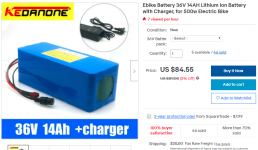
https://www.ebay.com/itm/Li-ion-Battery-36V-14AH-Volt-Rechargeable-Bicycle-500W-E-Bike-Electric-Li-ion/193153814065?_trkparms=aid%3D111001%26algo%3DREC.SEED%26ao%3D1%26asc%3D20160811114145%26meid%3D588c4e15f0de41a89a231c03f14b342a%26pid%3D100667%26rk%3D5%26rkt%3D8%26mehot%3Dnone%26sd%3D162671415726%26itm%3D193153814065%26pmt%3D1%26noa%3D1%26pg%3D2334524&_trksid=p2334524.c100667.m2042
https://prnt.sc/t3ko10
https://www.ebay.com/itm/Li-ion-Battery-36V-14AH-Volt-Rechargeable-Bicycle-500W-E-Bike-Electric-Li-ion/303574914430?hash=item46ae79957e:g
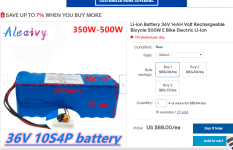
https://www.ebay.com/itm/Li-ion-Battery-36V-14AH-Volt-Rechargeable-Bicycle-500W-E-Bike-Electric-Li-ion/193153814065?_trkparms=aid%3D111001%26algo%3DREC.SEED%26ao%3D1%26asc%3D20160811114145%26meid%3Db6ffb38763914798a5ddf0d0ba444b79%26pid%3D100667%26rk%3D2%26rkt%3D8%26mehot%3Dnone%26sd%3D303574914430%26itm%3D193153814065%26pmt%3D1%26noa%3D1%26pg%3D2334524&_trksid=p2334524.c100667.m2042
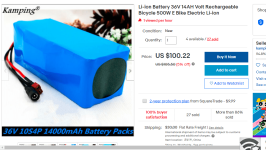
Are these the real deal ?
https://www.ebay.com/itm/Self-Balacing-Electric-Board-Replacement-Battery-AUTHENTIC-SAMSUNG/162671415726?hash=item25dff8d1ae:g:fgoAAOSwDRxZuBOb
https://prnt.sc/t3kn6a
Thanks.
LC. out.
Attachments
latecurtis
100 MW
As the Hub Motor Turns and the LiPo Fire Burns. Are they even broke in yet ??????
The charger gets hot so know it is putting out it's rated charging current. It was a hot day and they had no ventilation at all. It also took about 8 hours to charge. The light on the charger just turned green. If they charged in half that time I would suspect fake cells. Figure approximately 42V FULL to approximately 36V after the trip and approximately 8 hours to get back to 42V.
The charging current is on the charger so should be a formula to determine approximate pack capacity based on that.
42V - 2 amps * 8 hours. 36V - 42V respectively.
ok.
I will parallel the new pack up to those and call it a day. 80 new cells total for propulsion or 8P. Fake or real Samsung cells.
If they do happen to be Genuine Samsung packs I will be ordering at least two more next month.
Please let me know in detail how this internal resistance test works. I have seen capacity tests on you tube.
All I know is I finally did parallel up the old packs even though they are probably less than 50% of original capacity. It is 10P now so together with the new fake Samsung pack I have 140 cells total and soon will have 180 cells total when the two hoverboard packs show up. I should be good for 40 miles total or 20 miles in any direction. I wont be happy though until I can go 100 miles or 50 miles in any direction. Thanks.
LC. out.
The charger gets hot so know it is putting out it's rated charging current. It was a hot day and they had no ventilation at all. It also took about 8 hours to charge. The light on the charger just turned green. If they charged in half that time I would suspect fake cells. Figure approximately 42V FULL to approximately 36V after the trip and approximately 8 hours to get back to 42V.
The charging current is on the charger so should be a formula to determine approximate pack capacity based on that.
42V - 2 amps * 8 hours. 36V - 42V respectively.
ok.

I will parallel the new pack up to those and call it a day. 80 new cells total for propulsion or 8P. Fake or real Samsung cells.
If they do happen to be Genuine Samsung packs I will be ordering at least two more next month.
Please let me know in detail how this internal resistance test works. I have seen capacity tests on you tube.
All I know is I finally did parallel up the old packs even though they are probably less than 50% of original capacity. It is 10P now so together with the new fake Samsung pack I have 140 cells total and soon will have 180 cells total when the two hoverboard packs show up. I should be good for 40 miles total or 20 miles in any direction. I wont be happy though until I can go 100 miles or 50 miles in any direction. Thanks.
LC. out.
latecurtis
100 MW
I just have an old multimeter.
I was going to replace it with a new one and was considering hooking the old one to the handlebars for a battery gauge which should show SAG of voltage climbing hills but decided to use the extra bullets to combine the 4P - SONA packs to the 6P Samsung packs and am glad I did as there was no spark at all hooking them together and the charger toped off the packs. In a few minutes the packs went from red to green on the charger.
However as I stated earlier I am looking for a formula to determine the approximate capacity of the new FAKE or real Samsung pack. I know from experience charging both the old 4P SONA packs and the old 6P Samsung packs that they both charged in about 4 to 6 hours on the one charger. I own three 36V lithium ion chargers now. The first two are about 3 years old. I got one with the 4P SONA packs and one with the 6P Samsung packs. Neither came with the packs but were ordered separate. One is red when charging and turns green when charged and it gets hot. The other is red and blinks green and when charged is just green however takes a lot longer to charge. It gets barley warm and sometimes takes a whole day to charge the old packs.
I also stated that it was a hot day and the sun was out and very poor ventilation when running the new pack today. Also very little pedal assist and the packs were getting broke in. I wont be making any of those mistakes again as will provide ventilation and get better gears for pedal assist. I just need to get it to a shop soon.
On a good note I wont need to run the new pack again until I parallel them up with the two packs I just ordered which are supposed to be real genuine Samsung packs for hover board. They in fact might be the same as my old 6P Samsung packs. They look very similar and also were 4.4 AH. I ordered 4 of them about 3 years ago and one was defective but did not send it back as they refunded me part of the money. They are in storage and took apart. I have a few 18650 cells to test for a 2P pack which can parallel with the 2P - LG pack which survived my infamous big mistake about 15 months ago in NY hooking to a switch for a dead short and failure of cheap BMS.
Once I get all the storage here I will have another 4P to add to the old 10P pack but will have no room so might order a lot of 100 or even 200 tested used cells to build a massive 60V pack for the 3,000W brushless monster motor I plan on ordering for a 45 mph e bike project. :lol: Thanks.
:lol: Thanks.
LC. out.
I was going to replace it with a new one and was considering hooking the old one to the handlebars for a battery gauge which should show SAG of voltage climbing hills but decided to use the extra bullets to combine the 4P - SONA packs to the 6P Samsung packs and am glad I did as there was no spark at all hooking them together and the charger toped off the packs. In a few minutes the packs went from red to green on the charger.
However as I stated earlier I am looking for a formula to determine the approximate capacity of the new FAKE or real Samsung pack. I know from experience charging both the old 4P SONA packs and the old 6P Samsung packs that they both charged in about 4 to 6 hours on the one charger. I own three 36V lithium ion chargers now. The first two are about 3 years old. I got one with the 4P SONA packs and one with the 6P Samsung packs. Neither came with the packs but were ordered separate. One is red when charging and turns green when charged and it gets hot. The other is red and blinks green and when charged is just green however takes a lot longer to charge. It gets barley warm and sometimes takes a whole day to charge the old packs.
I also stated that it was a hot day and the sun was out and very poor ventilation when running the new pack today. Also very little pedal assist and the packs were getting broke in. I wont be making any of those mistakes again as will provide ventilation and get better gears for pedal assist. I just need to get it to a shop soon.
On a good note I wont need to run the new pack again until I parallel them up with the two packs I just ordered which are supposed to be real genuine Samsung packs for hover board. They in fact might be the same as my old 6P Samsung packs. They look very similar and also were 4.4 AH. I ordered 4 of them about 3 years ago and one was defective but did not send it back as they refunded me part of the money. They are in storage and took apart. I have a few 18650 cells to test for a 2P pack which can parallel with the 2P - LG pack which survived my infamous big mistake about 15 months ago in NY hooking to a switch for a dead short and failure of cheap BMS.
Once I get all the storage here I will have another 4P to add to the old 10P pack but will have no room so might order a lot of 100 or even 200 tested used cells to build a massive 60V pack for the 3,000W brushless monster motor I plan on ordering for a 45 mph e bike project.
LC. out.
Sunder
10 MW
latecurtis said:However as I stated earlier I am looking for a formula to determine the approximate capacity of the new FAKE or real Samsung pack.
One doesn't exist. A cheap battery could take longer to charge than a good one for the same capacity, because cheap batteries generally have high internal resistance.
For example, if you had a 2A charger, a genuine 10S4P INR18650-32A would have a 250mOhm internal resistance Edit: Apologies, using the wrong model of Samsung batteries. If they are genuine INR18650-33G, they should be around 110mOhm for the pack, given a <45mOhm per cell according to the data sheet.
A typical fake for an eBike would have about a 1000mOhm resistance. So the genuine would charge to 95% capacity before the internal resistance became the limiting factor. However, the fake would only charge to 75% capacity before the internal resistance became the limiting factor.
So with a higher resistance, it would actually take LONGER for the fake battery to charge, assuming it's even near the same capacity.
Measuring is the only way to find out the internal resistance of the battery.
You can use a proper internal resistance tool:
https://www.ebay.com/itm/Digital-Battery-Internal-Resistance-Meter-Battery-Voltage-Tester-with-Backlight/252469330660?_trkparms=ispr%3D1&hash=item3ac85842e4:g:iucAAOSwNwhcfNxX&amdata=enc%3DAQAFAAACcBaobrjLl8XobRIiIML1V4Imu%252Fn%252BzU5L90Z278x5ickkrDx%252B2NLp21dg6hHbHAkGMcJrZo%252BGMBC7NQxAZN2zJQfF5XD4J%252FLYdQGIot%252FSJ7itDcDgXDEPdjQ2eLiFsUM1rNIjAp3bmyykINGKfa7kEHDy0vH6AJ4iA0uFJXM9F3wECYwXKHv7k3NRZALfmEsok3sN0Js%252B%252F9aQRuFT9h7G4Zc%252BucU%252FfgvsDb4%252BsC3WPqzum4T0k9HLwJxEMfz2qW9gfHY7NVvFoZu80qgfdz5jBIc6%252FFLyY9J9%252FDgPiijCBg4efHYK%252Be%252FyedCTzu2BuQRyQGlwV%252F5bwNQRHbzXUdYFIBhswE3nmAHufarhcO6NrS559QWubcLk6%252FUpKkhqx5U8eAuS3mSM6GRQVLKHeIquHJfNwusmfyYmyECxFhSuu00orpfsv3ZkHnrtOnrQOtn2FUw6le1c7HAtLuDhOiyZQMF3Vy5Yje7ZAc5idKvqCko62qbZxqn7FgKh7g15jMMA5n%252B%252BVZ9oRpRzH4tFs5cgiErCpB1t03uZNO3i1ZxiNzVlS2BhGc04fsM1klsQQiPSGae6jTbS1GImpEEpdQRNGqUtEGs4D9mBRa8WYvjz1%252F14Sr%252BNtFgctkvdlEmVM%252F1fY82Gx2QQ9wYTwUTTZBfKMGsuvr9WHWYkDxeeLL4hYbcO97PqiA1cg8oTc1owhpGnXrsfCpyvd2FMvzkPPL5ZMbcT49CS4MuYe1qeVyx5moIweJixokILM%252B3APam%252FMFWTYAwUI77UWgN0M%252FGpoNl1U1VY22W%252FxRlzjP%252BGmNoyiPWDTviKdvi5P%252BqbFmbcZoOgIg%253D%253D%26cksum%3D252469330660765af674491b47eba65115b9e3dfaae1%26ampid%3DPL_CLK%26clp%3D2334524
You can measure and calculate it through a reference load using a standard multimeter:
https://learn.sparkfun.com/tutorials/measuring-internal-resistance-of-batteries/internal-resistance#:~:text=If%20we%20connect%20a%20load,voltage%20across%20the%20terminals%20drops.&text=This%20drop%20in%20voltage%20is,terminals%20with%20a%20load%20attached.
Or you can use an ammeter through a charger to do the same, but using the reverse maths.(Known current, rather than known load)
If you want to measure capacity, something like this is cheap enough:
https://www.ebay.com/itm/Voltage-Current-Ah-Capacity-Meter-DC-120V-50A-Charge-Discharge-AGM-SLA-Lead-Acid/162843831868?epid=1963030168&hash=item25ea3fae3c&_trkparms=ispr%3D1&amdata=enc%3DAQAFAAADUFf%252FDMNKL%252B9K9HATL6d5oTSiOfwV5GHJ%252FxEOsdp8J1AnGvOAC0q6aWIN%252B7HJGC6bgeaxaamfj0CetEEbRzIRimVfTWZNhaayIAuWJCIvJFE%252BiVIAQRoT%252FI6cU8uOab4IKyiESLCZiaEC4ogI%252FXA0XE%252FSStK8OjDXbRm6WozfNzcyKnxduQXy1eAxKkDvp%252BzRfnefmnyzt2cezP5tZqm8cEmzRv1zcaLu57A8wt4FfHshOmureDe51AvYLgCZxSICYLdV%252BbG0o4Sjy%252B87ImizSqC8WK%252FrP2cTc7friHbpXfET1wnSOV4HgiUN7mZTbojpo%252B7FUGiaw4jBU9es8iBuRf1SYVfCnVrAhnHd2w4vVH17JFXeR%252B5AeGv7m%252FIeV0wPfnGmdA5ZsnbE1Ae60KnfMFsZes9hVRtCsnvM2OyRFscrAehW3FlpwAfNq15jL%252Bk1M5IPcq0jzdlQMZ0fe2Nv%252BAJrmM2avFUN5trG3JAts3IWhq3vXojJ1HSL7ziXAcnvv%252FvcI5wOpRH2uTeOuKZBwPXT3Z%252B%252Bl8GL9PnEpvSpmwPriwElG6yDuEugp%252FfSnX6suBBegsF3V8UtYrbfu8d5IX1kNfmuySnpfDjBSwLoGRJv%252FjkGZ8DdcSUCjb960i68bAQnDEB8f8rMcrcwEI6Pi7VKpCRSt9%252F59MhFNBt1%252FyBMDsvh6mFTI4o6w2wvXHFH8X%252BkbJJJRJuwxaXGy0OWbiWuCTrs8R4TYF%252FlObri3d5N7I%252BXrCH%252F1kbGDuwVZXPEmGdDyoiJh3fKhQjBFBkd0UJly3KPryAp1BvKuNf6t%252BaPy8qsJ3WdE4YqKFJn4VsfXcJVTXM%252FmNTDLyO4GoMaWy5uwVf1wlP5PPMVSN2%252BdF%252FIsox9bqA%252Bpjh%252BWyYYmU2NU7xcG2ZU0WrsSBk0DM1gzg6YKInjhbAmRqE0PB%252BlA%252BSdrLtQbbZjs5I5Z14ZFFL%252Fcy%252F2qNerbg4pU01jXxzw3G92Qe9pSm9pdN6hFaoveK%252Bnj0%252BH8iel4NK09UIP5uxGBHn7yKTG6jdnu0GaZcqP6weUPUPQEIMjZVGjTnTCNSy2KpIzTenAf9lE5T3odO0ovI24l%252BAoEL4aS27H4UElajpUXwSXmNK8ErHm7fFTnSyu%26cksum%3D162843831868d5ee388f36cd472383c88debd1297b8c%26ampid%3DPL_CLK
latecurtis
100 MW
Awesome. I miss my e bike workshop. Those tools are exactly what I need. I would like to see what the measurements are on my old packs and compare to new packs as well as cells I may order in the future.
Basically my main objective of restarting my e bike workshop is in life support way over a year now. I need my stuff in storage.
I plan on ordering lots of 18650 cells 100 to 200+ about a year in the future and will need those tools then.
The next 6 months I need to acquire motor vehicle / vehicles. My storage in NY, and a larger place to reside.
Until then I am dealing with what I have and what is on the way already ordered.
Thanks.
LC. out.
Basically my main objective of restarting my e bike workshop is in life support way over a year now. I need my stuff in storage.
I plan on ordering lots of 18650 cells 100 to 200+ about a year in the future and will need those tools then.
The next 6 months I need to acquire motor vehicle / vehicles. My storage in NY, and a larger place to reside.
Until then I am dealing with what I have and what is on the way already ordered.
Thanks.
LC. out.
DAND214
10 MW
LC, I think you know what 2p,4p and 6p means. You are saying that a 6p Samsung was rated at 4;4Ah? Wow, you must get some real fake cells to be that bad. I bet Dura Cells would do better. I don't know of any 18650 to day tha are that bad. 6p would be 633mah per cell?? The 2p pack is 2200mah per cell. The 6p pack would be 3 times the size of the 2p and would it fit a HoverBoard? Stop buying the over rated stuff. I see 2p 4.4Ah Board packs for $33 from the atates with mo shipping. JUNK? Maybe but I would try a couple and see. Not these 14Ah packs for almost nothing.LC wrote:
On a good note I wont need to run the new pack again until I parallel them up with the two packs I just ordered which are supposed to be real genuine Samsung packs for hover board. They in fact might be the same as my old 6P Samsung packs. They look very similar and also were 4.4 AH. I ordered 4 of them about 3 years ago and one was defective but did not send it back as they refunded me part of the money. They are in storage and took apart. I have a few 18650 cells to test for a 2P pack which can parallel with the 2P - LG pack which survived my infamous big mistake about 15 months ago in NY hooking to a switch for a dead short and failure of cheap BMS.
Back to 12 miles, that's all? As I said you are over geared or major drag some where. OR maybe the pack is only a 8.8Ah pack just two of the HBOARD packs.
I almost bought a Ferrari for next to nothing but when I looked at the shipping I realized that USPS was doing the delivery, I figured out it was a fake
Dan
latecurtis
100 MW
LC, I think you know what 2p,4p and 6p means. You are saying that a 6p Samsung was rated at 4;4Ah? Wow, you must get some real fake cells to be that bad. I bet Dura Cells would do better.
No that is not what I meant.
Skalabala I think recommended them I think. They were 2P - 20 Genuine Samsung cells hooked to a BMS and rated at 4.4 Ah.
I ordered four for 8P. One was 2V lower than the others so ran it by itself to see what would happen and did not even make it a mile on flat at 10 mph so I tried to send it back and got a partial refund instead.
I ran 6P Samsung for over 3 years now. The SONA packs I ordered about 6 months before the Samsung which were also 4.4 Ah-2P.
I ordered two of those for 4P. All those old packs are finally in parallel now. I did that yesterday.
The new pack was 4P to start for 175 bucks. It might be a fake but do not feel like sending it back. Instead I will come up with a way to ventilate it and will hook it in parallel to two - 2P - 4.4Ah packs I ordered last night that boast Genuine Samsung cells.
So the old packs that are in parallel now are rated at 4.4 Ah * 6 = 26.4Ah. However since they have been run at 4P and 6P separately their entire life it is safe to say they are about 50% original capacity or approximately 13 Ah.
When I get the two new packs for 8P that will be 4.4 * 2 = 8.8Ah + the fake cells which are rated at 14 Ah but probably closer to 7 Ah if they are Fake cells so am looking at 8.8 Ah + 7 = 15.8Ah but will call it 15 Ah.
That is important as if the old packs which are 13 Ah @ 50% capacity then on long distance I can safely say if the old packs get me to a destination then the new packs should get me back home.
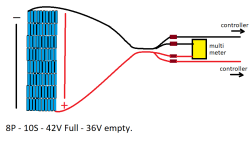
The multi meter I have is old and does not stay calibrated. It is all over the place and eligible for the bone yard. :lol:
I am looking at doing this. Would it work. I would need the extra bullets though to unplug the meter so it can be calibrated from time to time so need to buy two identical meters and a pack of 9V batteries to power and calibrate them. Would that work for a battery gauge ?
The bottom pic is another idea to improve overall battery life as heat is the enemy. It will require a separate 12V battery and two high speed/output fans.
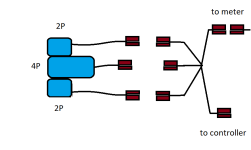
I ordered a pack of 5 bullets and the new 4P pack has bullets so will need 3 more bullets to do that. I will need to throw 20 or 30 bucks in my account from a different account as there is not much left in there now. I may as well order a second pack of 5 bullets so I have a couple extra. If these 2P - 4.4Ah packs are worth it I will be ordering a lot of them.
In fact the battery gauge will give me a good idea of each packs capacity as can run each of the 2P Samsung packs separate on the flat for about 5 miles at the same speed and then the 4P - pack the same speed and distance and compare the voltage. If the voltage is the same for the 2P packs as the 4P pack then I will know the 4P pack is Fake and the 2P packs are genuine. That method would also give me a general idea how much capacity the 100 old cells in parallel has.
In the bottom pic the PVC coming in will be smaller than the PVC going out. It would be where the wires come out to the controller but not much larger so it does not pull in a lot of hot air. The fan would not need to be large either or move a lot of air. The idea is to move the heat out NOT blow a lot of hot air in. The wood brace will keep batteries from moving up and down when hitting bumps.
Please let me know if that could work. Thanks.
LC. out.
Attachments
DrkAngel
1 GW
Posted this for you, before and before!
A simple, cheap powerful tool ... that I adopted as a basic necessity.
Lighted LCD is clearly visable, day or night.
Still < $11.
PS With a battery of reasonable size, discharging at modest C-rate, battery heat production is minimal and not considered an issue!
Moreover, condensation on a cold battery, might be damaging/dangerous.
A simple, cheap powerful tool ... that I adopted as a basic necessity.
Lighted LCD is clearly visable, day or night.
Still < $11.
DrkAngel said:Posted this up for you before ...
I run in series between battery and controller (with XT60 plugs)
Fairly weather resistant, lighted LCD for day or night use. Volt, Amp, Watt, Ah meter < $10
Soldering is not the tortuous wizardry that you make it out to be ... if, you would only follow our recommendations!
Wire nuts and/or twisted wires with electrical tape are lazy, infantile shortcuts that are doomed towards problems >> failures!
.
PS With a battery of reasonable size, discharging at modest C-rate, battery heat production is minimal and not considered an issue!
Moreover, condensation on a cold battery, might be damaging/dangerous.
latecurtis
100 MW
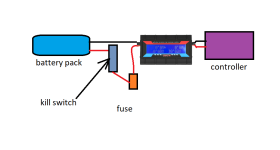
I will be ordering that then.
I really did not want to buy a Coleman cooler and all that stuff and haul freezer packs around anyway :lol: I just need to have some air flow. I might still get a fan though.
Is that the way that meter hooks up ?
Please let me know as will be ordering that very soon.
Thank you again DA for RE - posting that. I know I am a stubborn individual and unorthodox in my ways but do appreciate your advice and friendship. We have all been together awhile. You, Dan , Sunder and many others. I really look forwards to your posts.
Most of the people and all that post regular and years I consider close friends. I respect even more than many people I am friends with I met in person.
You guys are awesome.
https://www.youtube.com/watch?v=WjJ-kpgps1c
I need to study.
Thanks.
LC. out.
DrkAngel
1 GW
Setup looks OK except, putting "kill switch" after meter retains Ah used if shut down for any length.
latecurtis
100 MW
Setup looks OK except, putting "kill switch" after meter retains Ah used if shut down for any length.
OH.
I thought about that and makes sense.
Sometimes realizing something or comprehending a situation or even the mechanics of an institution can give oneself a euphorbia. l
enjoy embracing knowledge. E bikes are a miracle and will continue posting as long as I am breathing.
Thanks.
LC. out.
Sunder
10 MW
Just remember that the device will also drain the battery. As long as the BMS works properly, that's fine for fairly long periods, but if it fails, it will kill the battery.
If course, if it's just connected using connectors, you can always disconnect it for storage.
If course, if it's just connected using connectors, you can always disconnect it for storage.
latecurtis
100 MW
If course, if it's just connected using connectors, you can always disconnect it for storage.
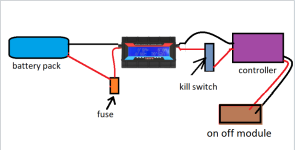
I charge the batteries upstairs. DA. said to put the kill switch AFTER the meter.
Only the bike I ride now and Easy Street have the separate module as it comes with e bikeling motor kits. I see what you are saying though. Even after I hit the kill switch the meter is still hooked up so will need two kill switches. If I plan on leaving the batteries hooked up for any length of time. In fact it would be easier to just leave it the way it is and hook up a new kill switch after the meter. If I am just stopping somewhere before returning home I can leave the meter on so I do not lose information. I actually do not need two kill switches as I have the module to turn the controller off and on but with my other bikes that do not have the separate module I will need two switches.
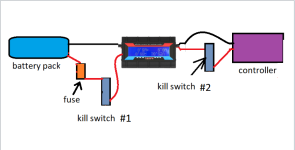
That should work. I will need to turn off the meter separate if I were to store the bike in a van or storage unit with the batteries hooked up. I am glad you brought that up. As of now I unhook the battery and bring it up stairs to charge. I also lug the bike up three flights of stairs. I take the front wheel off first lock up the bike and bring up the batteries and front wheel and go back down for the bike. If I have a lot of stuff I lock up the bike first and make three trips.
I also need to order heavy duty switches. The one I got I replaced last summer as was shorting out. Auto Zone did not have a better one so will now need to order two online. Thanks.
LC. out.
Rassy
1 MW
LC, your last diagram is very close to what I have used for years with one small variation..
I have always used the original Watts Up meter, which was expensive and is no longer available, but their instruction sheet always required you to power up the meter before powering up the controller and when I ignored that instruction, i.e., just one power up switch ahead of the meter, the meter soon quit working. Other than that some of my Watts Up meters are a decade old and still working and I always fully power up the meter before I power up the controller.
The variation is, I do not install a fuse because a use a dc breaker as the switches and have never had one fail:
https://www.amazon.com/MidNite-Solar-Photovoltaic-Circuit-Breaker/dp/B004EQJS1S/ref=sxts_sxwds-bia-wc-p13n1_0?cv_ct_cx=dc+breaker&dchild=1&hvadid=78615205602774&hvbmt=be&hvdev=c&hvqmt=e&keywords=dc+breaker&pd_rd_i=B004EQJS1S&pd_rd_r=cb2df54f-9820-4df3-9729-e28e3520d6c6&pd_rd_w=kdRDD&pd_rd_wg=j9uqm&pf_rd_p=7f71fdcf-aa37-4d97-b40d-864dcfdc13e5&pf_rd_r=K7KPPJJX5QE68PDB85H5&psc=1&qid=1593047569&sr=1-1-beb77b32-1078-477f-b152-b09baa1ee7f7&tag=mh0b-20
This is just an example and not a recommendation. These breakers have become pretty common and are used extensively in the solar industry. Initially I found them used on electric scooters as the on/off switch. The nice thing about them is that they not only hide the big spark that is initiated when the capacitor in the controller fills up, but they are designed to handle that spark without damage. The actual breaker comes in various amperage ratings.
I have always used the original Watts Up meter, which was expensive and is no longer available, but their instruction sheet always required you to power up the meter before powering up the controller and when I ignored that instruction, i.e., just one power up switch ahead of the meter, the meter soon quit working. Other than that some of my Watts Up meters are a decade old and still working and I always fully power up the meter before I power up the controller.
The variation is, I do not install a fuse because a use a dc breaker as the switches and have never had one fail:
https://www.amazon.com/MidNite-Solar-Photovoltaic-Circuit-Breaker/dp/B004EQJS1S/ref=sxts_sxwds-bia-wc-p13n1_0?cv_ct_cx=dc+breaker&dchild=1&hvadid=78615205602774&hvbmt=be&hvdev=c&hvqmt=e&keywords=dc+breaker&pd_rd_i=B004EQJS1S&pd_rd_r=cb2df54f-9820-4df3-9729-e28e3520d6c6&pd_rd_w=kdRDD&pd_rd_wg=j9uqm&pf_rd_p=7f71fdcf-aa37-4d97-b40d-864dcfdc13e5&pf_rd_r=K7KPPJJX5QE68PDB85H5&psc=1&qid=1593047569&sr=1-1-beb77b32-1078-477f-b152-b09baa1ee7f7&tag=mh0b-20
This is just an example and not a recommendation. These breakers have become pretty common and are used extensively in the solar industry. Initially I found them used on electric scooters as the on/off switch. The nice thing about them is that they not only hide the big spark that is initiated when the capacitor in the controller fills up, but they are designed to handle that spark without damage. The actual breaker comes in various amperage ratings.
latecurtis
100 MW
I have always used the original Watts Up meter, which was expensive and is no longer available, but their instruction sheet always required you to power up the meter before powering up the controller and when I ignored that instruction, i.e., just one power up switch ahead of the meter, the meter soon quit working. Other than that some of my Watts Up meters are a decade old and still working and I always fully power up the meter before I power up the controller.
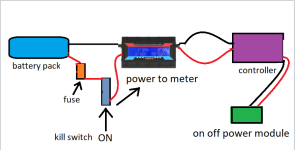
Ahead of the meter you mean between the meter and the controller. NOT between the battery and the meter ?????
Since the on and off module can not possibly get power with the kill switch turned off then it would be impossible to burn out the meter with this set up right ?
I am looking for a better switch so would the device you posted take the place of both the fuse and the switch in this diagram ?
I still have to order the meter and extra bullets. Thanks and please let me know.
LC. out.
Rassy
1 MW
To read my comment correctly, I always think of all current flowing from the battery, at least in the case of the positive current. So the word ahead of the meter would mean between the battery and the meter.
I do use the DC breaker in place of the fuse since they have the same purpose. Think about it like your house wiring where AC breakers have replaced all the fuses that we used to use.
If I understand what you are asking, the answer is no. If you turned on kill switch 2 before turning on kill switch 1 the meter could still be affected by the inrush of current to fill the capacitor in the controller. This could also affect kill switch 1 if the contacts in it were not as good as those kill switch 2. Of course if you always turn on kill switch 1 first and killswitch 2 second you will not have any problem.
In your diagram, there is nothing wrong with using a fuse and a plain switch, even an AC rated switch, that can handle the maximum amperage.
I do normally leave my meter running for my entire ride even though I sometimes turn off kill switch 2 which makes the trike inoperative and also turns off some lights that come on automatically when kill switch 2 is turned on.
Having pretty much completed the discussion on this I'm going to throw out an alternative wiring technique I sometimes use. For this only a low capacity switch is needed to power up the meter and I would not label it a kill switch because it does not kill the electric assist system. That is done by kill switch 2.
First, you will note in the meter instructions that only the negative wire needs to continue to the controller. I.e. the positive wire does not have to run through the meter on it's way to the controller. So I run a positive wire directly from the battery to kill switch 2 and from kill switch 2 on to the controller, and a negative wire directly to the meter and then on to the controller.
This will run your electric assist system just fine, but of course your meter will not turn on. In order to turn the meter on I run a light gauge wire from the input side of kill switch 2 (breaker), to a light duty switch, and to the input side of the meter.
You now have a system that works exactly the same as your diagram, but only has one heavy duty switch (breaker). I don't call the light duty switch a kill switch because it only turns off the meter at the end of the day. You still need to turn the meter on first so it is not affected by the capacitor surge. Hope you found this alternative interesting and not confusing.
I do use the DC breaker in place of the fuse since they have the same purpose. Think about it like your house wiring where AC breakers have replaced all the fuses that we used to use.
Since the on and off module can not possibly get power with the kill switch turned off then it would be impossible to burn out the meter with this set up right ?
If I understand what you are asking, the answer is no. If you turned on kill switch 2 before turning on kill switch 1 the meter could still be affected by the inrush of current to fill the capacitor in the controller. This could also affect kill switch 1 if the contacts in it were not as good as those kill switch 2. Of course if you always turn on kill switch 1 first and killswitch 2 second you will not have any problem.
In your diagram, there is nothing wrong with using a fuse and a plain switch, even an AC rated switch, that can handle the maximum amperage.
I do normally leave my meter running for my entire ride even though I sometimes turn off kill switch 2 which makes the trike inoperative and also turns off some lights that come on automatically when kill switch 2 is turned on.
Having pretty much completed the discussion on this I'm going to throw out an alternative wiring technique I sometimes use. For this only a low capacity switch is needed to power up the meter and I would not label it a kill switch because it does not kill the electric assist system. That is done by kill switch 2.
First, you will note in the meter instructions that only the negative wire needs to continue to the controller. I.e. the positive wire does not have to run through the meter on it's way to the controller. So I run a positive wire directly from the battery to kill switch 2 and from kill switch 2 on to the controller, and a negative wire directly to the meter and then on to the controller.
This will run your electric assist system just fine, but of course your meter will not turn on. In order to turn the meter on I run a light gauge wire from the input side of kill switch 2 (breaker), to a light duty switch, and to the input side of the meter.
You now have a system that works exactly the same as your diagram, but only has one heavy duty switch (breaker). I don't call the light duty switch a kill switch because it only turns off the meter at the end of the day. You still need to turn the meter on first so it is not affected by the capacitor surge. Hope you found this alternative interesting and not confusing.
latecurtis
100 MW
If I understand what you are asking, the answer is no. If you turned on the power switch before turning on the kill switch the meter could still be affected by the inrush of current to fill the capacitor in the controller. This could also affect the kill switch if the contacts in it were not as good as those needed in the power switch. Of course if you always turn on the kill switch first and the power switch second you will not have any problem.
IF I did turn on the power via the module BEFORE I hit the kill switch I do not believe that it would turn on as there would be no power going to it. The on button on the module has to press it in and hold the button for a few seconds and then the thing lights up,
With no power going to it it will do NOTHING. I always hit the kill switch first anyway before pressing the button on the module.
When I shut everything down I always flip the kill switch first however I believe that if I wanted to keep the METER on with power going to it to save the data for the entire trip awhile going into a store then I could just push and hold the power button on the module to turn that off and the meter should stay on. Then press and hold the button on the module to turn on the controller ???
First, you will note in the meter instructions that only the negative wire needs to continue to the controller. I.e. the positive wire does not have to run through the meter on it's way to the controller. So I run a positive wire directly from the battery to the power switch and from the power switch on to the controller, and a negative wire directly to the meter and then on to the controller.
Kind of confusing but will try a diagram. If it works there is no chance to burn out the meter as I could put in a smaller fuse to the meter as electrons flow in one direction however my question would be the accuracy of the meter as the current and power going thru the meter would not be the same as the controller. The only thing which would be the same is the voltage.
That would be ok for me though as I am looking at voltage and do not care about watts or amps. I just would rather NOT run my packs below 36V and maybe switch packs at 37V to prolong the life of the packs due to voltage SAG. If I were to moniter voltage SAG then could switch packs as soon as voltage SAG reads < 36V on the meter.
Watts and amps are unimportant as I can measure the capacity of the packs by calculation of distance traveled. For example we will measure the distance from point A to point B via google maps. If one 36V pack is at 38.5V at point B at approx. 10 mph and a second pack is at 36.5V at point B then I know the first pack has a greater capacity than the second pack. It also measures voltage SAG going up hills so I do not kill the pack. I can switch the packs if voltage SAG is < 36V. It is why I considered just hooking up a multimeter in the first place in parallel with the controller.
Now I am curious so please let me know. Thanks.
LC. out.
Attachments
Rassy
1 MW
I do normally leave my meter running for my entire ride even though I sometimes turn off the power switch which makes the trike inoperative and also turns off some lights that come on automatically when the power switch is turned on.
Rassy
1 MW
I'm sorry LC, but I missed something in your diagram and did not notice that your power switch is not in line between the battery and the controller. I will have to modify my previous response, but have to look at it a bit first.
Edit, I see there was a previous diagram that did have two switches between the battery and the controller. Still need to review some.
Edit, Ok, your power switch that turns on the controller is all after the fact in relation to my part of this discussion. It is common for a controller to require a secondary switch like that before it will turn on.
In my experience the capacitor is filled as soon as the battery is connected to the controller and thus happens before the power switch is turned on, and that is when the pesky spark is created. I will now go back and edit previous posts as needed, mostly just terminology where I was calling the switch between the meter and the controller a power switch and may have made the statement confusing.
Edit, I see there was a previous diagram that did have two switches between the battery and the controller. Still need to review some.
Edit, Ok, your power switch that turns on the controller is all after the fact in relation to my part of this discussion. It is common for a controller to require a secondary switch like that before it will turn on.
In my experience the capacitor is filled as soon as the battery is connected to the controller and thus happens before the power switch is turned on, and that is when the pesky spark is created. I will now go back and edit previous posts as needed, mostly just terminology where I was calling the switch between the meter and the controller a power switch and may have made the statement confusing.
- Status
- Not open for further replies.
Similar threads
- Replies
- 27
- Views
- 629
- Replies
- 16
- Views
- 1,738
- Replies
- 31
- Views
- 2,767
- Replies
- 0
- Views
- 151
- Replies
- 28
- Views
- 1,729


